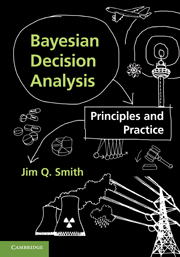6 - Multiattribute utility theory
from Part II - Multidimensional Decision Modelling
Published online by Cambridge University Press: 05 June 2012
Summary
Introduction
So far this book has given a systematic methodology that can be used to address and solve some simple decision problems. However some of the most interesting and challenging real decision problems can have many facets. It is therefore necessary to extend the Bayesian methodology described earlier in the book so that it is a genuinely operational tool for addressing the types of to complex decision problems regularly encountered. Even for moderately sized problems we have seen the advantages of disaggregating a problem into smaller components and then using the rules of probability and expectation within a suitable qualitative framework to draw the different features of a problem into a coherent whole. Although the appropriate decomposition to use depends on the problem addressed there are nevertheless some well-studied decomposition methods that are appropriate for a wide range of decision problem which the analyst is likely to encounter frequently. The remainder of this book will focus on the justification, description and enaction of some of these different methodologies.
When addressing the formal development of simpler models we began by developing a methodology constructing a justifiable articulation and quantification of a DM's preferences. In particular in Chapter 3 a formal rationale was developed describing when and why a DM should be guided into choosing a utility maximising decision rule. But techniques are needed to apply these methods effectively when the vector of attributes of the DM's utility function is moderately large.
- Type
- Chapter
- Information
- Bayesian Decision AnalysisPrinciples and Practice, pp. 169 - 198Publisher: Cambridge University PressPrint publication year: 2010

